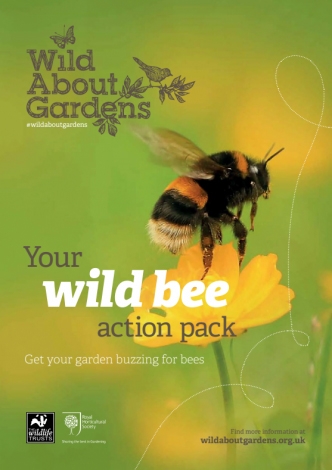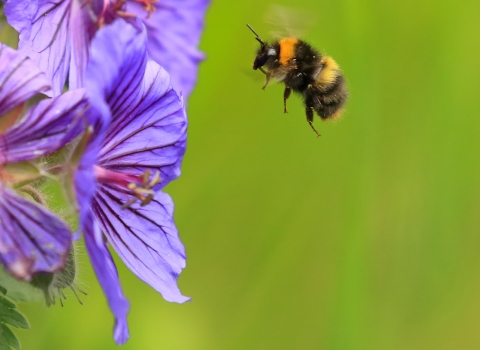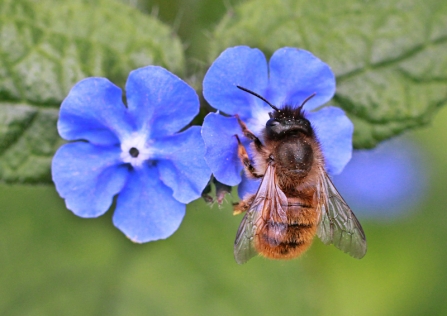Just imagine if everyone in North Wales sowed a mini meadow in a corner of every garden/yard this year, what a difference we could collectively make…
We need bees!
You might be surprised to learn that there are around 270 species of bees in the UK!
These include 1 honey bee species, 24 bumblebees and the rest are different species of solitary bees, which come in many colours, shapes and sizes.
Did you know that bees provide us with every third mouthful of food we eat? Without bees, we would be unable to grow lots of our favourite foods, including tomatoes, blueberries, strawberries and green beans.
It’s no secret that bees and other pollinators are facing significant threats from habitat loss, disease and the overuse of pesticides, but with a little work, your garden can serve as a fantastic habitat for a wide range of bee species throughout the year.
There are lots of ways you can help bees in your garden ...
Feed the bees!
Plant a diverse range of nectar rich flowering plants and shrubs that bloom at different times of the year. Have a look at our planting lists and if you have a few of each you will ensure that there is nectar all year round in your garden.
Plants for all pollinators through the seasons
Choose a mixture of seasonal flowering plants, shrubs and trees to ensure a year round food source in your garden. Look on our meadow pages for ideas on wildflowers.
Winter:
Winter heathers, mahonia, crocus, snow drops, witch hazel, Viburnum tinus, sweet box
Spring:
Aubretia, alyssum, Bowles’ mauve perennial wallflower, blackthorn, bluebell, blackberry, bugle, clover, comfrey, native cowslip, crocus, cuckoo flower, dandelion, dicentra, field scabious, forget-me-not, flowering currant, heathers, honesty, lungwort, ox-eye daisy, native primrose, goat and grey willow, sweet rocket, violets, wallflower
Summer:
Allium, aster (Novi-angliae cultivars and Aster amellus and its cultivars; these two species are not invasive), aquilegia, borage, bugloss, california lilac, campanula, catmint, chives, corn flower, globe thistle, hardy geraniums (cranesbills), escallonia, evening primrose, foxglove, heathers, hebe, honeysuckle, Jacob’s ladder, lamb’s ear, lavender, lobelia, lupins, marjoram, marigolds, mint, nasturtium, Phacelia tanacetifolia, phlox, poppy, rock-rose, rosemary, sage, scabious, salvia species, sea holly, sweet william, sunflower, thyme, verbena, viburnum, viper’s bugloss, yarrow
Autumn:
catmint, cone flower, cosmos, hemp agrimony, fleabane, heathers, ivy, knapweed, lucerne, michaelmas daisy, Sedum spectabile ‘Ice Plant’, St John’s wort, teasel, thistles
Create nesting sites
From minors to masons, different bee species choose a variety of places to set up home. Grassy tussocks are used by different species of bee and bumble bee for nesting. It is also worth leaving some bare patches of soil in the garden as mud is used by mason bees for making nests. Mining bees make their homes under the ground especially in sandy soils
You can easily provide additional nesting sites for solitary bees by drilling holes (between 2-10mm in diameter and 6-10cm deep) in logs or old fence posts in sunny sites or bundle together stems with holes in them as nesting sites. These are best placed in a sunny site/ sunny wall of the garden.
Water for bees
Can you create a wildlife pond? Or alternatively, how about a pot sunk into the ground or a bird bath containing a few submerged rocks to enable bees to reach the water?
Encourage natural predators
- In a wildlife garden we aim to establish an ecologically balanced mini ecosystem.
- So don’t use chemicals like pesticides or fungicides in your garden.
- These will kill our important bees. Instead, encourage natural predators.
Make a bee box
Let Nick Baker show you how ...

Download your guide to helping bees
It’s no secret that many pollinators are facing threats. Insensitive land use, a reduction in plant species diversity and the use of insecticides have all been linked to declining bee numbers. This is bad news for us and for them. But you can help...


